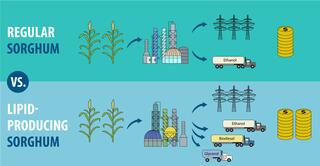Lipid-producing sorghum as a source of biodiesel

Improving sorghum’s ability to make lipids broadens its value as a bioenergy feedstock.
The Science
Great Lakes Bioenergy Research Center (GLBRC) scientists have developed a process model demonstrating that engineering energy sorghum for lipid production would increase the crop’s value as a bioenergy feedstock. Technoeconomic analysis reveals that engineering the plant to produce lipid content allows for refining into biodiesel. This alteration would result in a lower “minimum ethanol selling price” (MESP) than refining traditional energy sorghum.
The Impact
Engineering sorghum to produce lipids would allow for coproduction of biodiesel along with other fuels and bioproducts, making the bioenergy crop more valuable in a model bioenergy refinery than if ethanol were the only biofuel produced from the plant.
Summary
GLBRC scientists and engineers have sought to improve the value of perennial bioenergy crops, including energy sorghum. GLBRC scientists performed a technoeconomic assessment and estimated the MESP – the price at which a biofuel must be sold in order to break even after 30 years. Results showed that sorghum engineered to produce ten percent lipid content refined into biodiesel, ethanol, and other bioproducts would lower the MESP by $0.62 to $2.46/gal compared to $3.08/gal in ordinary energy sorghum, thereby resulting in a more profitable, integrated biorefinery. Further, increasing the lipid content to 13% generates an estimated MESP of $2.25/gal. According to the study, the most important factors in enhancing sorghum’s value are increasing its lipid content and extraction efficiency while reducing the solvent-to-solids ratio in the extraction process.
Program Manager
N. Kent Peters
Program Manager, Office of Biological and Environmental Research
kent.peters@science.doe.gov, 301-903-5549
Principal Investigator
Peyman Fasahati
University of Wisconsin–Madison
fasahati@wisc.edu
Funding
This work was funded by the DOE Great Lakes Bioenergy Research Center (DOE BER Office of Science DE-FC02-07ER64494). Dr. Saffron’s contribution was supported in part by the USDA National Institute of Food and Agriculture (Hatch project MICL02289) and Michigan State University AgBioResearch.
Publications
Fasahati, P. et al., “Process design and economics for production of advanced biofuels from genetically modified lipid−producing sorghum.” Applied Energy 239, pp. 1459-1470 (2019), DOI: 10.1016/j.apenergy.2019.01.143
Related Links
https://doi.org/10.1016/j.apenergy.2019.01.143